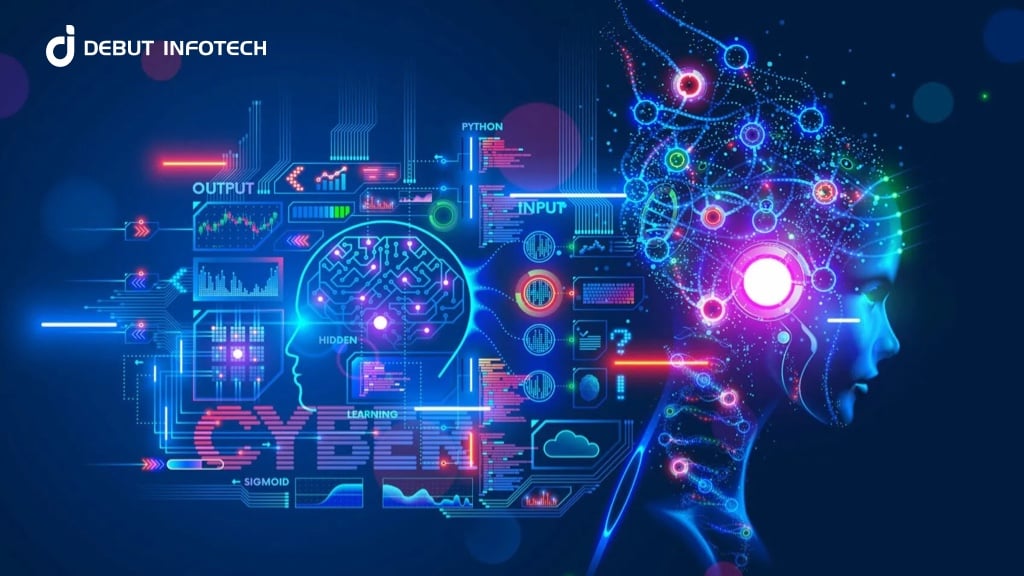While the capabilities of machine learning are impressive, the processes involved generate extensive data, which can inadvertently expose personal information. Moreover, machine learning systems are not immune to limitations, often leading to errors or biased outcomes.
To address these issues, integrating human judgment into machine learning can significantly enhance the quality of its insights. However, this approach comes with its own set of tradeoffs, even for reliable machine learning consulting firms. Privacy is a critical consideration that raises ethical concerns about collecting and storing personal data to improve application accuracy. In this article, we’ll explore the intersection of machine learning and privacy, outlining practical steps to safeguard data in AI/ML applications.
Data Privacy and Machine Learning
Many machine learning challenges involve using private data, and the issue is that these models often retain sensitive information, even when they are not explicitly overfitting.
For over three decades, anonymization has been the go-to method for balancing data utility with privacy. The principle is straightforward: if your data exists but cannot be linked back to you, your privacy is preserved. However, anonymization has its limitations. When statistical analysis is applied, data leaks can occur—even when the intent is not to extract identifiable details.
The privacy implications of AI and machine learning often receive less attention than they deserve. Yet, ensuring machine learning privacy is critical when training and testing models, particularly those handling sensitive or personal information. Striking the right balance between utility and confidentiality remains a key challenge in the field. But, with the help of top-rated companies offering machine learning development services, it’s less stressful.
Ensure Data Privacy
Machine learning models rely on vast datasets to attain high accuracy. Still, the data they process often contains deeply sensitive and personal information. This raises a crucial question: how can we completely leverage the potential of AI while safeguarding data privacy?
Before diving into this privacy experts guide to AI and ML, and the tools and techniques available, let’s consider a few fundamental components that play a critical role in preserving privacy. They are:
-
Training Data Privacy: Ensures that no malicious actor can reverse-engineer or reconstruct the sensitive information contained in the training data.
-
Input Privacy: Guarantees that user-provided data remains completely confidential, preventing even developers from accessing it. This safeguard builds trust and maintains user confidentiality.
-
Output Privacy: Protects the model’s results, ensuring that the output is exclusively accessible to the user whose data was used for inference. This prevents unauthorized access or misuse of the insights generated.
-
Model Privacy: Provides assurance that the model itself is secure and cannot be stolen or replicated by malicious individuals or groups, protecting intellectual property and data integrity.
Key Components to Ensure Privacy
Let’s explore several tools and techniques that can help protect data privacy during machine learning model training.
1. Differential Privacy
Differential Privacy evaluates the privacy of mechanisms that access data and generate outputs. It’s one of the most reliable techniques for safeguarding privacy in machine learning.
To illustrate, consider training a model on a medical dataset to predict whether a patient has cancer. Initially, the model predicts with 55% confidence that John has cancer. Now, suppose John’s data is added to the dataset, and the model is retrained. The updated model predicts a 57% confidence level (Case A). This slight change does not strongly indicate that John has cancer.
However, suppose the retrained model predicts an 80% confidence level (Case B). In that case, the increase becomes significant and potentially reveals sensitive insights about John’s health. Differential Privacy helps mitigate such risks by ensuring the model’s predictions do not inadvertently disclose individual data contributions.
This example demonstrates how a machine learning model can unintentionally leak information. Each time the model’s predictions change significantly due to the addition or removal of a specific data record, sensitive details may be revealed.
Despite its robust privacy safeguards, Differential Privacy is often compatible with effective data analysis. It can even enhance outcomes by mitigating overfitting. Its benefits extend beyond security, offering a well-rounded approach to privacy and model performance.
The primary objective of Differential Privacy is to minimize ML privacy loss. By providing mathematically verifiable assurances, it addresses various privacy challenges with precision and reliability.
Pros of Differential Privacy
-
Data remains on remote machines, reducing exposure.
-
Enables detailed privacy budgeting for controlled risk management.
Cons of Differential Privacy
-
While data security is maintained, model security may be at risk.
-
Calculations across multiple data sources can be challenging.
2. Remote Execution
Remote execution enables you to test and execute workloads while transferring intensive processing tasks to a server. This method is particularly useful for developing and testing analytics. In essence, it facilitates the use of R commands or Python-based operations on a remote machine, such as another Machine Learning Server instance, without requiring direct access.
For example, leveraging tools like PyTorch for privacy-preserving machine learning involves importing libraries like `syft` and `torch` and employing the `TorchHook` feature. This setup enhances PyTorch by integrating privacy-preserving techniques into the workflow.
Here are the approaches to enable remote execution:
-
Running through console programs via command line interfaces.
-
Calling APIs directly from your code.
Pros
-
Data remains securely stored on remote machines, minimizing exposure.
Cons
-
A key challenge is how to perform meaningful data analysis without directly viewing the data.
3. Search and Example Data
This feature allows you to conduct meaningful data analysis without directly accessing or viewing the dataset. For instance, if you wish to perform a specific analysis, you can search for a dataset and receive references to the remote data along with metadata. This metadata includes details such as the schema, data collection methods, and distribution patterns, providing crucial context for your work.
Pros
-
Data remains securely stored on a remote machine, reducing the risk of exposure.
-
Enables feature engineering using sample data, enhancing analysis capabilities.
Cons
-
Data theft remains a potential risk through methods like `PointerTensor.get()`.
4. Secure Multi-Party Computation
Secure Multi-Party Computation (SMPC) enables multiple parties to jointly compute a function using their private inputs without revealing those inputs to each other. This technique involves encrypting a value and splitting it among several stakeholders. The original encrypted value remains hidden, ensuring no individual participant can uncover the complete data due to the encryption process.
Key Advantages
-
Data remains securely stored on a remote machine, reducing the risk of exposure.
-
Provides a formal and detailed framework for privacy budgeting.
-
The model can be encrypted during the training process, enhancing security.
-
Supports collaborative tasks across multiple data owners, making it ideal for decentralized data environments.
Dealing with Sensitive Data
Organizations handling sensitive data must comply with a range of regulations, such as PCI certification, ISO 27001, and GDPR (General Data Protection Regulation), among others
Let’s explore some key considerations when working with sensitive information:
1. Data Access
Machine learning operations often require cross-disciplinary collaboration, involving teams from various fields. Machine learning development companies, engineers, and data scientists need the flexibility to perform their tasks efficiently without compromising consumer security and ML privacy.
These professionals must have access to production images, enabling them to inspect, test, and analyze data in a controlled manner. The ability to conduct exploratory data analysis, prototype rapidly, and visually assess data is essential. However, this must be balanced with stringent access control, audit logging, and physical security protocols to ensure compliance and protect privacy.
-
Access Control: Limit data access exclusively to individuals who genuinely need it.
-
Audit Logging: Maintain detailed records of all data access activities, capturing who accessed the data, when, and where it occurred.
-
Exploratory Data Analysis: Facilitate the ability of ML engineers and data scientists to swiftly derive key statistical insights from the input data stream to understand its modality effectively.
2. Dataset Governance
Datasets used for training and evaluating machine learning and AI models must be sourced from the vast, often disorganized, data lake created by incoming data streams. Proper organization and management of this data are crucial for maintaining model quality and security.
a) Cryptography
Encrypting all data, both in transit and at rest, is a fundamental requirement. No one should find out that their personal data has been included in decommissioned datasets or transferred over the internet without encryption. Safeguarding data with robust encryption methods is vital for ensuring privacy and security.
b) Retention of Datasets
Organizations often handle derived data in machine learning, which can include personally identifiable information (PII). To mitigate the risk of retaining invisible PII, a clear and enforced data retention policy is essential. This ensures that unnecessary or sensitive data is discarded after a defined period, minimizing exposure.
c) Consent
In the data universe, many organizations overlook the importance of obtaining explicit consent. Only data from clients who have granted permission should be used for machine learning purposes. This ensures that data processing is aligned with legal and ethical standards, and builds trust with users.
3. Model Productionalization
The machine learning lifecycle extends beyond model training. Once a model is deployed, new challenges arise when running models in production systems, especially when working with dynamic data rather than a single, static dataset. Addressing these challenges is crucial during the development of ML infrastructure.
a) Reproducibility
The ability to efficiently retrain a model using updated dataset versions is essential for maintaining a high-quality service. Reproducibility ensures that models can adapt to new data, supporting continuous improvement and reliability over time.
b) Online Monitoring
When dealing with sensitive information, such as identity verification, attackers often attempt to manipulate the system. To counter this, it’s essential to continuously monitor production models. Effective online monitoring helps detect concept drift and ensures that models remain accurate and secure in real-world applications.
Conclusion
As machine learning continues to evolve, the use of personally identifiable information (PII) to train models becomes increasingly common. However, this practice demands significant responsibility and care. Developers must prioritize data privacy and security to reduce the risks associated with handling sensitive data.
Advanced privacy-preserving methods like differential privacy and secure multi-party computation are essential for safeguarding sensitive data while solving complex challenges. Organizations should also implement automated, continuous monitoring to maintain compliance and detect vulnerabilities.
Debut Infotech stands out as a leader in machine learning model development, prioritizing data privacy and strict adherence to global privacy regulations. As a top AI development company, they integrate advanced privacy-preserving techniques, ensuring compliance with laws like GDPR while delivering high-performance solutions. With a commitment to secure data handling, Debut Infotech empowers businesses to leverage AI responsibly, safeguarding sensitive information throughout the ML lifecycle. Their expertise in privacy-conscious AI development makes them the ideal partner for organizations seeking innovative, secure, and reliable machine learning solutions tailored to meet modern compliance standards.
Caroline is doing her graduation in IT from the University of South California but keens to work as a freelance blogger. She loves to write on the latest information about IoT, technology, and business. She has innovative ideas and shares her experience with her readers.




![‘Bugonia’ Review – Lanthimos Shoots For Brilliance With Emma Stone & Jesse Plemons In A Madcap World Gone Wrong [Telluride 2025] ‘Bugonia’ Review – Lanthimos Shoots For Brilliance With Emma Stone & Jesse Plemons In A Madcap World Gone Wrong [Telluride 2025]](https://cdn.geekvibesnation.com/wp-media-folder-geek-vibes-nation/wp-content/uploads/2025/09/Emma_Stone_Bugonia-300x169.avif)

